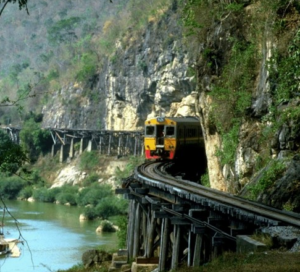
A Distant Memory
Over the River Kwai in western Thailand is a particular bridge that today bears tourists on creaky railway cars high above the muddy waters. The trip across takes a mere three minutes and after that the railroad winds into the dense foliage toward (but not into) Burma.
This is no ordinary bridge and no ordinary railway. It is the epitaph of thousands of young men who suffered or died building this crossing. Around the world this site is known as the ‘Death Railway’. Those three minutes, and the thirty more minutes beyond into the forest where the train stops, are a moving monument to the best and the worst in human affairs.
Despite the present appearance of a calm rural railway crossing, history hangs heavy in this place. On a visit to this marker, my unexpected encounter with a stranger transformed this silent sylvan place into a vivid testament about the events that once happened here.
Witness to History
Ron Paine drew my attention when I heard him speaking with an English accent during our lunch stop at the jungle restaurant. This tree-shaded place was the furthest point west the train could go at the present time. Beyond lay the forbidden territory of Burma where warfare still erupted between tribes and political parties. Paine’s age also piqued my curiosity: he was in his seventies, old enough to remember the holocausts of World War II.
After most of the other tourists had finished eating and wandered off, I leaned toward this tall man with the silver hair and asked if he knew, by chance, anyone who had been part of the Kwai bridge history. I expected the usual lack of knowledge that most western tourists have about history, especially the events of the war in Asia. Instead, he turned and looked at me through steady blue eyes: “Yes…me. I was here.”
 Caught off guard, I replied foolishly, “you were here? You helped built the bridge and railroad?” Responding to my surprise and disbelief, he gently reassured me, “yes, I was…for three years” without adding any emphasis to his voice. He hardly needed emphasis to make his point. (photo left Ron Paine)
Caught off guard, I replied foolishly, “you were here? You helped built the bridge and railroad?” Responding to my surprise and disbelief, he gently reassured me, “yes, I was…for three years” without adding any emphasis to his voice. He hardly needed emphasis to make his point. (photo left Ron Paine)
With his words, my tour through smoothed-over history to this quiet forested site suddenly became a vivid wartime story testified by a sentient survivor whose hand I could touch and whose voice resonated in my mind.
I hesitated for a moment. I had a dozen questions to ask but I didn’t have permission to intrude. I thought he must have been asked many times over the decades what happened to him here. Perhaps he wanted to keep most of those indelible Ron Paine memories buried and finished.
But it’s hard for an old soldier to resist telling his most important war story to someone younger who is obviously full of curiosity. It was equally hard for me to resist inviting myself into this man’s personal museum, his personal Armageddon.
So he offered, in a calm even voice, that the Japanese had captured him in 1942. Originally, and still, from Manchester , UK, he had been shipped overseas to Singapore to defend that threatened British outpost. When the Japanese troops swept over the area he was forcibly conscripted along with thousands of other POW’s to work as slaves for the Japanese war machine as it pushed westward.
Ron Paine and other prisoners were packed 60 men to a boxcar with little food and no sanitation for three days up the Malaysian peninsula to Bangkok and then west to the river town of Kanchanaburi. When the prisoners arrived, they had no idea what lay in store for them. They saw a river and a jungle.
It was then 1943 and Tokyo, in its peak of hubris, had ordered the construction of a direct rail route to India on their way to control of all Asia. That meant going straight through the jungles and mountains of Thailand and Burma. It also meant an enormous amount of tortuous labor hacking through dense jungle by hand and, worse, breaking through rocky cliffs and hills with sledgehammers.
Here, under extreme duress and despair, at the age of 21, Paine lived for three years of his life without any communication with his country, his family or his friends. It was the worst three years of his long life. (photo left, tourist train crossing trestle)
Tortured Memories
Recalling the ruthless treatment at the hands of his captors, he is convinced the Japanese are the cruelest people imaginable. They showed little mercy for their prisoners of war, despite international agreements for the humane treatment of POW’s. Instead, these captives were mercilessly forced to live like beasts of burden as unpaid slaves in diseased and unsanitary conditions. Over half the prisoners did not survive.
A particular harrowing memory was the time he and some buddies, who were perpetually starving, tried to sneak into camp some bananas that had been secretly supplied by local Thai villagers. To their great distress, the guards discovered them.
For this offense, Paine and his buddies were rounded up; a rope was tied around his neck which connected down his front to a bamboo stick placed behind his bent knees so that he could not stand up straight. His hands also were tied, tightly behind him. In this debilitating position he was left–sweating, hungry and in pain–for three days with only a little water to drink. He recalled that other soldiers, for their punishment, had their stomachs pumped full of water and then were kicked in the belly by their captors.
(At the time of my visit, the near-by ‘JEATH Museum’ in Kachanaburi housed a display of torture instruments along with photos of the brutality. I subsequently heard that the current Japanese government had protested the museum’s presence and the Thai authorities were considering closing it. JEATH stands for Japan, England, America/Australia, Thailand, and Holland–the six countries whose captured soldiers were involved with the construction of the ‘Death Railway’ as it came to be known.)
Paine retold these horrors in a voice virtually detached of emotion, as if in the voice of a narrator of events that long ago had been sealed in a file of acquittal and acceptance. “You have to let go at some point; you don’t want give them a second chance”, he told me later.
For food the railway captives usually ate little more than rice and hibiscus leaves. The work stretched from six a.m. until midnight everyday. Sometimes, at night, they collapsed into sleep outside even in the monsoon rains since their primitive bamboo huts were so hot and suffocating. Few men ever tried to escape as there was nowhere to go and trying to navigate through the jungle was hopeless and if a local native were caught trying to help an escapee, it was sure and sudden death for both.
 As he described the harrowing events, he said it was commonly accepted among the captives that for every railroad tie installed, one prisoner’s life was sacrificed. The railroad was 263 kms (about 157 miles) in Thailand and 152 kms (90 miles) in Burma. Thirty thousand prisoners from allied countries were forced into labor at the Thailand end of the rail line and more than 100,000 forced laborers from India, China, Thailand, Burma, Malaysia and Singapore started work from the Burmese end. Of the allied prisoners, more than 16,000 died of disease (cholera), exhaustion, torture or starvation.
As he described the harrowing events, he said it was commonly accepted among the captives that for every railroad tie installed, one prisoner’s life was sacrificed. The railroad was 263 kms (about 157 miles) in Thailand and 152 kms (90 miles) in Burma. Thirty thousand prisoners from allied countries were forced into labor at the Thailand end of the rail line and more than 100,000 forced laborers from India, China, Thailand, Burma, Malaysia and Singapore started work from the Burmese end. Of the allied prisoners, more than 16,000 died of disease (cholera), exhaustion, torture or starvation.
By the time Paine (who stood at six-foot-one) was liberated in 1945, he weighed a mere 105 pounds. What was estimated to be a five-year project through the jungle was rammed to completion in a harrowing sixteen months–with an even greater loss of lives among the Asian laborers digging from the west.
Deception and Hatred
Ron recounted how the prisoners actually built two bridges. The first was wooden with enormously heavy teak logs used as pilings. Even the elephants sometimes couldn’t move the huge timbers, so the task was put upon the prisoners to haul them down to the river, often demanding hundreds of sweaty backs to get the wood into place. It was literally backbreaking work and many men collapsed. If they fell, they were beaten or shot by the vicious guards. Many just died of fatigue, their bodies completely depleted of strength and nourishment. Their will to live was broken.
 Of course, the POW’s did not want the Japanese to succeed in their westward invasion, so they built the bridge as poorly as they could. But when the first train barely made it across the creaky bridge, the Japanese realized the deception and were furious, both because of the flaws in structure as well as the delays involved. Paine said the camp commander immediately announced that after this, the next railroad car across would be filled with fellow prisoners. Needless to say, the builders went back and strengthened the trestles and pilings.
Of course, the POW’s did not want the Japanese to succeed in their westward invasion, so they built the bridge as poorly as they could. But when the first train barely made it across the creaky bridge, the Japanese realized the deception and were furious, both because of the flaws in structure as well as the delays involved. Paine said the camp commander immediately announced that after this, the next railroad car across would be filled with fellow prisoners. Needless to say, the builders went back and strengthened the trestles and pilings.
As if this labor were not exhausting enough, when the western allies made bombing raids over enemy territory, a year later, they took out the bridge. This forced the construction of a second bridge further upstream by another wave of captured workers. This time, steel trusses were used that had been made in Tokyo and shipped by barge up the river. This is the bridge that stands today with iron identification plates ‘made in Tokyo’ still visible.
Reassignment
After the construction of the first bridge, Ron Paine was shipped to Japan to work the coal mines just outside Nagasaki. The Japanese had depleted their domestic workforce in order to fill their military ranks.
One day, about year later, as he was unloading a hopper of ore outside the mine, he saw a tremendous flash of light in the sky and heard the subsequent thunderous explosion. He and the other workers had no idea what had happened, but they could tell something very different had occurred. He stood in awe, his mouth agape, and watched as the huge mushroom cloud formed over the distant city.
At first the Japanese guards discounted any significance to this explosion, but Paine said they were visibly shaken and nervous. They threatened to kill all the prisoners working there in the mine.
But over the next few days, word came of the devastation imposed by the two atomic bombings and the subsequent Japanese surrender. Most long-term prisoners had been so badly treated they were afraid at first that their guards would now kill them in revenge. But orders came from the Imperial Command to lay down arms and abandon their posts.
Ron Paine came down from the black mine and, at the age of twenty-five, this emaciated prisoner became a free man once again.
Redemption
It was chaotic: the Japanese destruction, the turmoil of surrender, the confusion and disarray of POW’s scrambling to find safe havens. Within a week he found a contingent of allied occupying forces. Like so many other POW’s missing for years, the first thing he thought about was sending notice to his anxious family that he was alive. They had heard nothing of his whereabouts for over three years.
And so began his return to sanity and health. He was first shipped to the USA and then Canada where he received medical care. Still in shock and disbelief, he was nurtured back toward his usual body weight and given a chance to tell his tormented story. About a month later, he was reunited into the welcoming arms of his family in England.
 He now speaks gently and softly. He does not want to see Japan ever again, but he feels a warmth and appreciation for the Thai people who helped in what little ways they could to relieve the suffering of the prisoners. “I know some of them were killed trying to help. They didn’t understand the enemy. I sure did, though”, he reflected.
He now speaks gently and softly. He does not want to see Japan ever again, but he feels a warmth and appreciation for the Thai people who helped in what little ways they could to relieve the suffering of the prisoners. “I know some of them were killed trying to help. They didn’t understand the enemy. I sure did, though”, he reflected.
This trip back to the River Kwai was his third in the many years since the war. His wife, walking by his side, told me he has made his peace with the past: the muddy river, the thick jungle, his fallen comrades–and with himself. But he will never forgive his tormentors, she said quietly.
His presence in our tour group imprinted him in my memory of this land and of the lives of those who did not survive. They remain, most of them in their twenties, buried in the local allied cemetery of honor in Kachanaburi, the ghosts of the ‘Death Railway’.
The jungle is quiet now. The thick green flora tightly covers the hills and huddles along the riverbanks. The bridge visit had started as a typical tourist ride to a famous place (mostly remembered from the ’50’s Hollywood film starring Alec Guinness). But thanks to a valiant warrior, my journey of fiction changed into an event of honor, heroism and poignant reality.
Also see:
Tears, Sex and Floods in Thailand
















